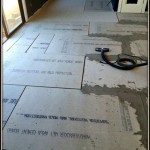Can You Lay Vinyl On Top of Tiles? A Comprehensive Guide
The question of whether vinyl flooring can be installed over existing tile is a common one for homeowners considering renovations. The answer is, typically, yes, but with significant caveats. The success of this type of installation hinges on proper preparation and understanding the potential drawbacks. This article will delve into the necessary steps, potential issues, and best practices for laying vinyl flooring atop existing tile.
Vinyl flooring, prized for its durability, water resistance, and ease of maintenance, presents an attractive alternative to tile, especially in areas prone to moisture like kitchens and bathrooms. Furthermore, installing vinyl over tile can be a cost-effective solution, avoiding the expense and labor associated with removing the existing tile. However, neglecting crucial preparation steps can lead to a subpar outcome, impacting the longevity and aesthetics of the new flooring.
Preparation is Paramount: Assessing the Existing Tile
Before embarking on a vinyl over tile project, a thorough assessment of the existing tile is essential. The condition of the tile directly affects the outcome of the vinyl installation. The primary concern is identifying and addressing any imperfections in the tile surface.
Firstly, the tile must be level. Any significant height variations between tiles, or individual tiles that are cracked, chipped, or loose, require remediation. Unevenness will telegraph through the vinyl flooring, creating an unsightly and potentially uncomfortable surface. This can also lead to premature wear and tear on the vinyl, as it will be subjected to uneven stress points.
Secondly, loose tiles must be re-secured or removed and the resulting void filled. Loose tiles will shift and move, potentially cracking the vinyl above. Similarly, cracked or chipped tiles should be repaired with a patching compound specifically designed for tile. This patching compound should be allowed to cure completely according to the manufacturer's instructions before proceeding with the subsequent steps.
Thirdly, the tile surface must be thoroughly cleaned. Any dirt, grease, or debris will interfere with the adhesion of the leveling compound or the vinyl flooring itself. A degreasing cleaner is recommended, followed by a thorough rinse with clean water. Allow the tile surface to dry completely before moving on to the next stage.
Finally, inspect the grout lines. Deep grout lines can also telegraph through the vinyl. While some vinyl flooring is more forgiving than others, it is generally necessary to fill the grout lines to create a smooth, uniform surface. This is typically achieved using a self-leveling underlayment or a cement-based patching compound.
Choosing the Right Vinyl Flooring and Underlayment
The type of vinyl flooring selected plays a crucial role in the overall success of installing over tile. Different types of vinyl flooring have varying degrees of flexibility and thickness, impacting their ability to conceal imperfections in the underlying tile surface.
Luxury Vinyl Plank (LVP) and Luxury Vinyl Tile (LVT) are popular choices due to their thickness and durability. These options are generally more forgiving than sheet vinyl when it comes to minor imperfections in the tile surface. However, thinner sheet vinyl is less expensive but requires a perfectly smooth subfloor for optimal results, making it a less suitable choice for installation directly over tile without proper preparation.
The use of an underlayment is highly recommended, particularly when dealing with uneven tile surfaces. An underlayment provides a cushioning layer between the tile and the vinyl flooring, helping to absorb minor imperfections and improve the overall feel of the floor. Furthermore, underlayment can offer additional benefits such as sound insulation and moisture resistance.
When selecting an underlayment, choose one specifically designed for use beneath vinyl flooring. Consider the thickness and density of the underlayment; thicker, denser underlayments will generally provide better cushioning and sound insulation. Also, ensure the underlayment is compatible with the adhesive used to install the vinyl flooring.
Some vinyl flooring products come with a pre-attached underlayment. While these can simplify the installation process, it is crucial to assess whether the integrated underlayment provides sufficient cushioning and sound insulation for the specific application. In some cases, an additional layer of underlayment may still be necessary.
Addressing Grout Lines and Leveling the Surface
As previously mentioned, grout lines are a significant concern when installing vinyl over tile. The depressions created by the grout lines can telegraph through the vinyl, creating an uneven and unattractive surface. Addressing these grout lines is crucial for achieving a professional-looking result.
Several methods can be used to fill grout lines. One common approach involves using a cement-based patching compound designed for filling grout lines. This compound should be applied with a trowel, ensuring that the grout lines are completely filled. Allow the compound to dry completely according to the manufacturer's instructions, then sand the surface smooth to create a seamless transition between the tile and the filled grout lines.
Another option is to use a self-leveling underlayment. Self-leveling underlayments are liquid mixtures that are poured onto the tile surface and allowed to spread and level themselves, creating a perfectly smooth subfloor. This method is particularly effective for addressing significant unevenness in the tile surface, as it can fill in low spots and create a uniform plane. However, self-leveling underlayments can be more expensive than patching compounds and require careful application to avoid creating air bubbles or other imperfections.
Regardless of the method used, it is essential to ensure that the surface is perfectly smooth and level before installing the vinyl flooring. Use a long straightedge to check for any remaining imperfections. If necessary, apply additional patching compound or self-leveling underlayment to correct any unevenness.
After the patching compound or self-leveling underlayment has dried completely, sand the surface smooth with fine-grit sandpaper. This will help to remove any imperfections and create a better surface for the vinyl flooring to adhere to. Vacuum the surface thoroughly to remove any dust or debris before proceeding with the installation.
Once the surface is properly prepared, the vinyl flooring can be installed according to the manufacturer's instructions. Whether using adhesive or a floating installation method, careful attention to detail is crucial for achieving a professional-looking result.
When using adhesive, apply it evenly to the prepared surface, following the manufacturer's recommendations for coverage and open time. Carefully position the vinyl flooring and press it firmly into the adhesive, ensuring that it is properly aligned. Use a roller to smooth out any air bubbles and ensure good contact between the vinyl and the adhesive.
For floating installations, ensure that the subfloor is clean and dry. Click-lock systems should be carefully engaged to ensure a tight, seamless fit. Use spacers along the perimeter of the room to allow for expansion and contraction. Follow all manufacturer's instructions for installation and maintenance.
In summary, laying vinyl over tile is a viable option for homeowners seeking to update their flooring without the hassle of tile removal. However, meticulous preparation, careful product selection, and diligent installation are paramount for achieving a successful and long-lasting result. By addressing the issues discussed above, homeowners can transform their space with the benefits of vinyl flooring while avoiding the complications of a more extensive renovation project. It is always prudent to consult with a flooring professional for guidance and advice tailored to the specific conditions of the project. This ensures proper assessment and application of appropriate methods for a successful outcome.

Installing Luxury Vinyl Over Existing Tiles Choices Flooring

Transform Your Home Installing Vinyl Flooring Over Ceramic Tiles City Wall And Floor

Can You Lay Vinyl Over Tiles Luxury Flooring Floorbay

Can You Put Vinyl Flooring Over Tile Igloo Surfaces

How To Lay Vinyl Flooring Sheet Over Tiles

How To Install Vinyl Flooring Over Tiles Linoleum Thrift Diving

Can You Put Vinyl Flooring Over Tile A Complete Guide Teka

Quick Guide To Laying Hybrid And Other Hard Flooring Over A Tile Floor

How To Tile Over Linoleum Floors Correctly

What Type Of Flooring Can You Install Over Ceramic Tile
Related Posts








